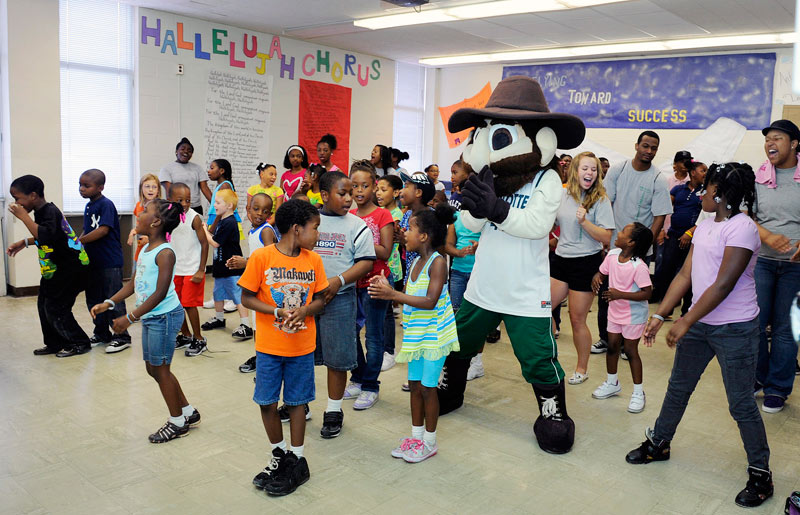The whole matter revolves around the self-respect of my people. How much satisfaction can I get from a court order for somebody to associate with me who does not wish me near them?
(Zora Neale Hurston, “Court Orders Can’t Make Races Mix”)
Through our personal and group contacts with other racial groups, we must increasingly win their understanding and support. Only in this way can the swelling force among minority racial groups be channeled into creative progress rather than explode into riots and conflicts, or dissipated into hoodlumism
(Mary McLeod Bethune, “What the Negro Wants”)
Two women literary figures – Mary McLeod Bethune and Zora Neale Hurston – historically embody two distinct stances on school desegregation. Both Bethune and Hurston shared tenure at Bethune College in Daytona Beach, Florida during the early 20th century, and were even “friends” at one point (Kaplan, 2002). Though many people today would consider these women to be iconic “liberationists” of some sort, their views on education – especially surrounding the 1954 Brown v. Board of Education decision – substantially differed from one another, which brings discussion to the role of desegregation and education.
Bethune was sixteen years older than Hurston, and one of Eleanor Roosevelt’s closest Friends. Bethune even served as a Black political advisor of President Franklin Roosevelt’s “Black Cabinet” (McClusky & Smith, 1999). With political progressivism in mind, Bethune seemed to be a powerful figure, a frontrunner even, in the eyes of desegregationists. Bethune, in What the Negro Wants, demanded, “We must challenge everywhere the principle and practice of enforced racial segregation. We must make it clear that where groups and individuals are striving for social and economic status, group isolation one from the other allows the rise of misunderstanding and suspicion, providing rich soil for the seeds of antagonism and conflict” (Bethune, 1944, p. 257). This stance on cultural and racial diversity uplifts the importance of inclusion and understanding.
Hurston, on the other hand, openly refuted theses views. In a letter to Countee Cullen regarding social desegregation efforts, Hurston writes:
Personally, I have no desire for White association except where I am sought and the pleasure is mutual. That feeling grows out of my own self-respect. However blue the eye or yellow the hair, I see no glory to myself in the contact unless there is something more than the accident of race (Kaplan, 2002, p. 481)
Hurston’s letter to Countee Cullen demonstrates a disdain for desegregation due to its obligatory implications, which suggest that Black association with Whites is somehow an added benefit.
She later took a public stance in an Orlando Sentential article, “Court Orders Can’t Make Races Mix.” She dispelled the notion that school desegregation would create any type of congeniality among races. She suggests:
If there are adequate Negro schools and prepared instructors and instruction, then there is nothing different except the presence of White people. For this reason, I regard the ruling of the U.S. Supreme Court as insulting rather than honoring my race. Since the days of the never-to-be-sufficiently-deplored Reconstruction, there has been current the belief that there is no greater delight to Negroes than the physical association with Whites.
Overall, Hurston viewed desegregation as disingenuous (Hurston, 1955). The statement above reflects Hurston’s claims about forceful integration. Hurston viewed desegregation as insulting, especially to the Southern Black communities that were properly educating their students. Racially segregated schools also guaranteed a sense of “safety” within its own racial exclusion, which would not warrant riots, lynching, or other forms of racial agitation. Hurston also predicted that racial desegregation efforts from the Brown vs. Board of Education decision, would be slow and detrimental to Blacks who were essentially – waiting for equality.
Although the two women never spoke directly to each other about the matter, both were vocal in local newspapers, diary entries, and other publications, about their support or disdain for the Supreme Court’s decision. Bethune supported the NAACP’s stance and viewed desegregation as advancement (Bethune, 1944; Meier & Rudwick, 1986). Meanwhile, Hurston’s opposition to the Brown case marginalized her from other Blacks interested in racial progression. After Hurston’s vocal dismissal of the Brown case, “…critics write off this period of [Hurston’s] life as a time of collapse and confusion, ‘a talent in ruins’” (Kaplan, 2002, p. 481).
This year marks the 60th anniversary of the landmark 1954 Brown v. Board of Education decision. While many applaud this court ruling, many educators today fear that the Brown v. Board decision has yielded unpromising results in efforts to produce equitable learning conditions, equal opportunities, and racial inclusion for students. Today – sixty years after the case – educators are divided in their stance on the positive effects of school desegregation, similar to the divide of Hurston and Bethune. Sadly, school desegregation was not the utopian ideal that many had hoped. In fact, the integration process caused many problems, both initially and progressively (Douglass, 1995). After the Brown v. Board decision, many school districts fired Black teachers out of retaliation (ibid.). In addition, many White teachers after the Brown case were forced to teach Black students, which indisputably caused turmoil and chaos in schools – as noted in the Little Rock Nine, the Clinton Twelve, and the case of Dorothy Counts at Harding High School (Douglass, 1995; Lenski, Crawford, Crumpler & Stallworth, 2005). Although many of these conflicts were expected initially, the progressive consequences of the 1954 Brown decision still linger today.
Using Charlotte, North Carolina as an example, school segregation is still a modern reality, which comes in the form of zip-code property tax zoning laws for schools. Figure 1 below displays Charlotte-Mecklenburg County data for the 2012-2013 school year. It is important to note that zip codes are synonymous with school placement, fiscal resources, and teacher quality. These characteristics are compounded when considering how many people believed that school desegregation was “solved” sixty years ago. As displayed below, racially grouped students are clustered in several dense areas of the city, including five zip codes in particular. These zip codes determine school placement, and are likewise representative of the school environment. There is a distinct racial divide, not uncommon to the 1950’s, which is a result of urbanization, modernization, and gentrification.


